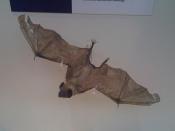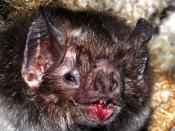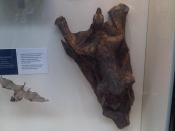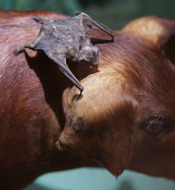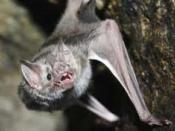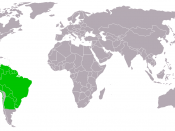The title of the Journal that I used is The Dynamics of Flight-Initiating Jumps in the Common Vampire Bat Desmodus rotundus and was written by William A. Schutt, Jr, J. Scott Altenbach, Young Hui Chang, Dennis M. Cullinane, Juhn W. Hermanson, Farouk Muradali, and John E. A. Bertram. The journal was accepted on September 15, 1997, and the article that I used was on page 3003 through 3012.
The most prominent question or concern that was probed in the article dealt with the "dynamics of jumping behavior in D. rotundus and to explore the functional characteristics of a wing operating under competing mechanical constraints." In other words, they were interested in the specifications of the flight-initiating jumps, and also interested about how the bat is able to utilize its wing for more than one purpose such as crawling, or moving without flight.
The hypothesis that was being implemented was that "the wing is expected to have design features that allow both powered flight and the generation of violent jumps."
The Demodus rotundus demonstrates intricate movements including flight-initiating jumps and because of this the wing is expected to be engineered for the ability to jump (to initiate flight) and also powered flight.
The prediction that was made for this experiment was that this experiment would follow the results that were observed by Altenbach in 1979, and 1988. That is, that the bat would indeed initiate its flight with a jump.
The tests that were imposed were the use of a force platform with twelve transducing elements. There were two horizontally oriented aluminum box beams holding up the platform. Short vertical beams at the end of each box beam attached to the supporting baseplate of the platform. An aluminum plate was glued to a honeycomb shaped piece of plastic. The platform was calibrated by using the methods outlined in Biewener and Full (1992). The platform's vertical and horizontal channels were calibrated to individually hold up to 10 N which equates to approximately 30 times the animal's weight. The platform was then used to calculate the animal's force that was exerted when jumping in order to initiate flight.
The data that was collected was that the Desmodus rotundus was able to, and consistently exerted a force of up to 9.5 times its weight in about 30ms while in the process of jumping. The average take off velocity was 2.38ms-1. It was determined that the jump sequence can be divided into three major phases, preparatory, jump and flight. Desmodus rotundus also consistently engages in a preparatory phase that includes a slight crouch before the actual jump.
In evaluating this experiment it is very clear that the results support the hypothesis. By testing the force exerted by the wings of Desmodus rotundus we can be aware of the power that they are capable of and in realizing that, it justifies the many uses of the wings. When comparing the hypothesis with the results we also find that the dynamics of flight that were proposed in the hypothesis were consistent with the actual experiment.
The experiment also confirmed the prediction that this experiment would agree with Altenbach in 1979, and 1988
